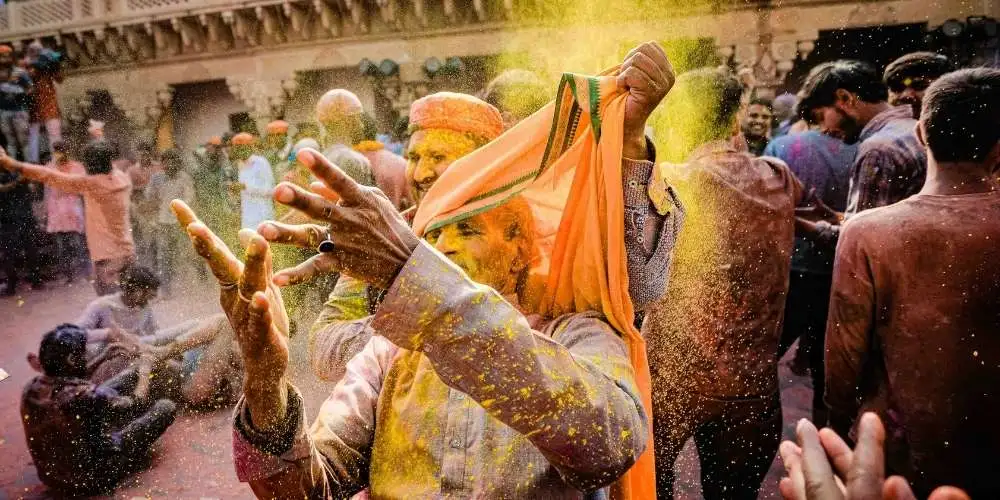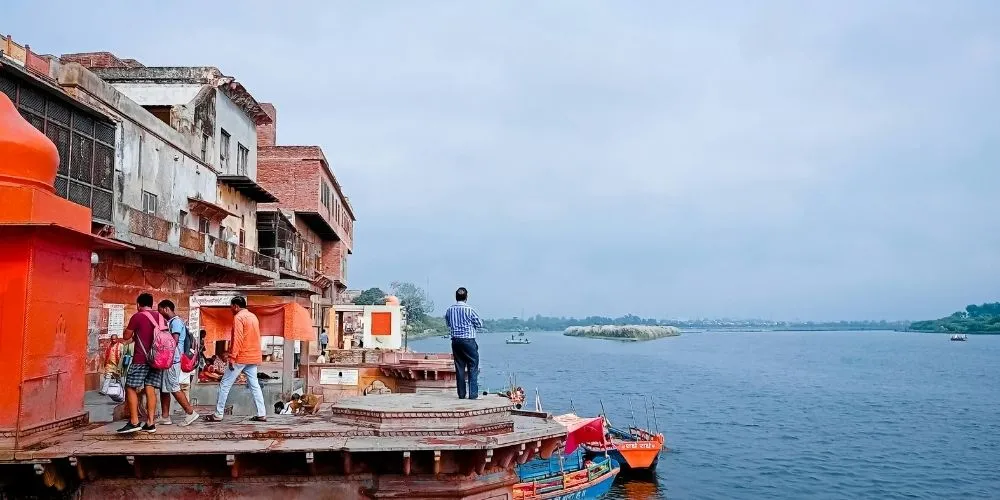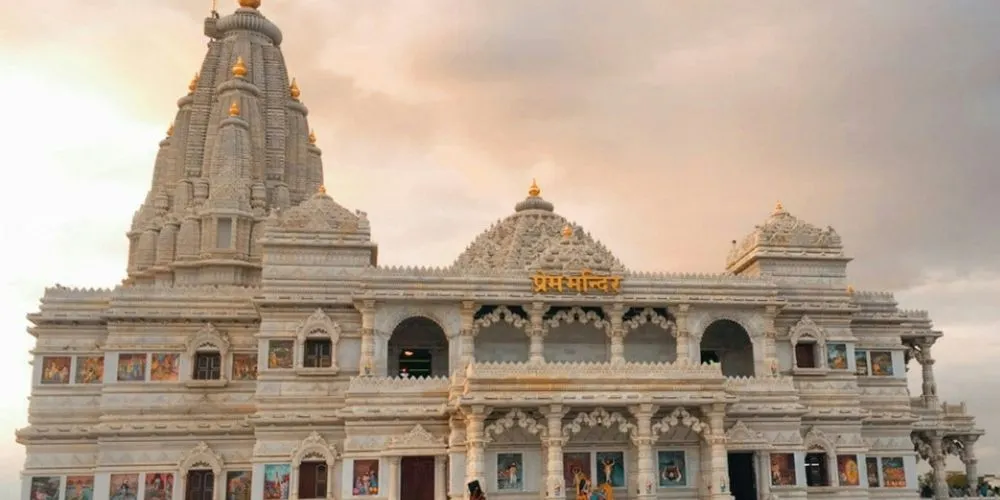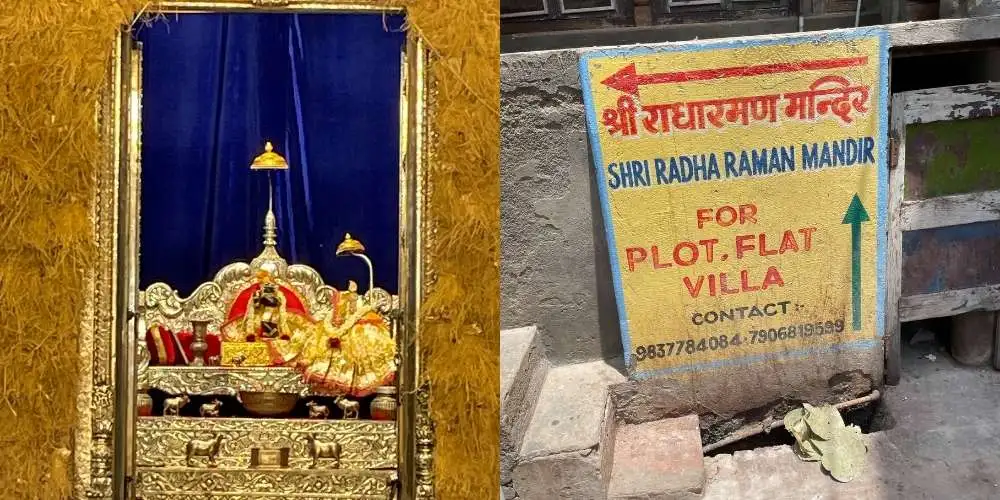For centuries, Vrindavan has been the beating heart of devotion and melody, where the holy lanes and the air vibrate with chants of “Radhe Radhe.” Situated in Uttar Pradesh’s Brij region, Vrindavan is renowned as the playground of Lord Krishna and Radha, making it a memorable pilgrimage and a magical holiday for travellers from far and wide.
Step out of your car or train, and Vrindavan’s holy environment greets you instantly; colourful flower vendors, priests chanting at every corner, the smell of incense rising from dim-lit shrines, and the constant hum of singing. Life flows by in slow motion here, giving you time to admire ancient ghats, hear street musicians (devotees), and greet gentle cows wandering the parikrama paths. Many come searching for peace, and the town’s sacred air is known to soothe spiritual seekers and regular visitors alike.
How to Reach Vrindavan
Vrindavan is well connected from Delhi (about 3 hours) and Agra (about 1 hour). The nearest railway station is Mathura Junction, situated 12 kms away, and local buses, cabs, or shared autos help cover the last few miles. For budget travellers or pilgrims, regular trains and Volvo buses run from major Uttar Pradesh and NCR cities to Mathura and onward autos serve the Vrindavan route. If you’re flying, the closest airport is at Agra. Once in Vrindavan town, local autos, battery rickshaws, and cycle rickshaws are the best ways to hop between temples and ghats; a fun, affordable way to move through narrow alleys.

Bankey Bihari Mandir Vrindavan
No visit to Vrindavan is complete without the darshan at Bankey Bihari Mandir Vrindavan, one of India’s most sacred Krishna shrines. Located in the bustling Loi Bazaar, the temple’s black idol of Krishna, standing in the Tribhanga posture, is known for its delicate beauty and deep spiritual presence. Uniquely, the temple does not allow continuous darshan; curtains are drawn frequently to shield devotees from the enchanting gaze of Bihari Ji, which legend says is too powerful for mortals to bear uninterrupted.
Inside, fragrant marigolds, devotional singing, and hundreds of visitors create an electric, yet heartwarming atmosphere. Festivals like Janmashtami and Holi are especially memorable, filling every corner with music, colours, and joyous crowds. Modest dress is a must; cover
shoulders and knees, avoid tight or flashy clothes, and skip photography, which is not allowed inside the temple.
Nidhivan: A Forest of Mystery and Faith
One of Vrindavan’s most mysterious and myth-laden corners, Nidhivan Vrindavan is a small forest grove with gnarled trees and an enchanting legend. Devotees believe Lord Krishna and Radha come here nightly to perform the Raas Leela, and the beds and offerings inside the temple’s Rang Mahal show inexplicable signs of use each morning. Entry at night is forbidden, adding to the air of mystery.
It’s also deeply linked to the origins of Bankey Bihari; said to be the spot where Swami Haridas first manifested the iconic idol after a vision of Shyama-Shyam. Besides religious awe, the unique twisted trees, quiet ambiance, and tiny shrines create a beautiful setting for prayer or simple reflection.
Adding the Parikrama experience to your Vrindavan journey is a must for every spiritual seeker and curious traveller; it’s not just a walk but a tradition that connects every step to centuries of devotion and divine love.
Vrindavan Parikrama
The Vrindavan Parikrama is the ritual circumambulation of the sacred town, covering a distance of roughly 15 kilometers. The route is not only a path but a tapestry of stories; legend says Krishna himself traced it with his pastimes. As you walk the Parikrama Marg, you pass key landmarks like ISKCON Mandir, Madan Mohan Temple (the oldest in Vrindavan), Kesi Ghat on the Yamuna River, Seva Kunj, Nidhivan, Imli Tala, Radha Damodar Temple, and the revered Govind Dev Mandir. Each site holds its own mythological charm and marks major episodes in Krishna’s life.

Parikrama Route and How Much Time It Takes
You can start Parikrama from any temple or ghat, though ISKCON Temple and Kesi Ghat are popular places to begin. Most devotees walk the route barefoot, chanting mantras and pausing to pray at significant temples. The entire journey can take anywhere from 2–6 hours; pace yourself depending on your stamina and the number of stops. Some split the walk over two days, dwelling longer at cherished spots for meditation or music.
Along the way, the air rings with “Radhe Radhe”. Senior citizens and those with health constraints use e-rickshaws or cycle in sections; if you’re fit, walking is the most immersive and spiritual way to enjoy the journey.
Essentials for Parikrama
- Clothing: Dress in light, modest cotton clothes; a traditional gamcha or stole is perfect for the walk.
- Shoes: Easy-slip chappals in case you prefer not to go barefoot; keep shoes safe from monkeys.
- Water & Snacks: Carry a filled bottle, energy bars or fruits; stay hydrated, especially in warmer months.
- Sun Protection: A cap, sunglasses, and sunscreen, as the route crosses open areas and ghats.
- Small bag: For money, phone, camera; keep valuables zipped and minimal to avoid monkey trouble.
- First Aid: Carry basic plasters and medicine if you have any health concerns.
- Map/Guide: Either save a map on your phone or pick up a printed route guide from local shops.
Safety & Local Tips
- Avoid carrying food openly; Vrindavan’s monkeys are notorious for snatching snacks, glasses, phones, and even bottled drinks.
- The path includes quiet stretches by ghats and gardens, so travelling with a group is safe and adds to the joy.
- Early mornings (5–9 AM) and late afternoons (after 5 PM) are best for Parikrama; you skip the heat and get the most peaceful atmosphere.
Best Time to Visit Vrindavan for Parikrama
October to March is ideal; the weather is cool, the town is lively but not stiflingly crowded, and you’ll enjoy festival seasons like Kartik (Oct-Nov) and Holi (March), which bring extra energy to Parikrama but also bigger crowds. Winters (December-February) are exquisite for long, leisurely walks and deeper immersion at each temple.
Must-Visit Places in Vrindavan
Beyond Nidhivan and Bankey Bihari Mandir, Vrindavan’s spiritual and architectural landscape delights at every bend:
- Prem Mandir: Beloved for its dazzling marble structure, intricate lighting, and sculpted panels narrating Krishna’s life.

- ISKCON Temple (Sri Krishna-Balaram Mandir): Global hub for Krishna consciousness; attend lively kirtans, eat at Govinda’s restaurant, and explore the museum.
- Radha Raman Temple: Famous for its auto-manifested deity and tranquil setting.

- Radha Vallabh Temple: Deeply symbolic for Radha-Krishna lovers, unique in its rituals.
- Seva Kunj: Lush, legendary garden believed to host Krishna’s nightly dances.
- Keshi Ghat: The Yamuna riverbank, stunning at sunset, and site of many devotional baths and aartis.
- Govind Dev Temple: Grand Mughal-era structure with intricate carvings, combining history and devotion.
For a touch of everyday Vrindavan, visit vibrant bazaars for beads, sweets, and flower garlands.
Where to Stay: Properties Near Temples
- Vrinda Kunja Ashram and Anand Dham Guesthouse are calm, budget-friendly and within walking distance of Bankey Bihari Mandir.
- Hotel Krishnam and Hotel Basera Vrindavan offer modern amenities with great locations.
- Dharamshalas and Ashrams like Sachdev Bhavan, ISKCON Seva Sadan, and Maa Shridevi Kripa Kalpataru provide affordable, spiritual stays, often with simple vegetarian meals and easy access to all major temples.
Book early in festival seasons (Holi, Janmashtami), as Vrindavan fills up fast.
Local Travel and Lesser Known Attractions
Getting around is easy; autos and e-rickshaws ply all major routes. Walks are pleasant in cooler months (October to March); avoid peak heat and busy festival days if you dislike crowds. For a deeper dive, check out smaller havelis, workshops of flute makers, and local aartis at the Yamuna ghats.
Hidden gems include Radharani Shringaar Ghar inside Nidhivan, ancient temples tucked into alleyways, and markets for regional sweets and trinkets.
What to Wear and What to Gorge on
Dress respectfully; kurta-pajamas, sarees, salwar suits, or long trousers and shirts work best for temple visits. Shoes should be easy to slip on/off.
Eat local: Enjoy kachori-sabzi for breakfast, Mathura peda, khurchan, and thandai at street stalls. Try lassi and freshly made sweets from Brijwasi and Shankar Mithaiwala. Strict vegetarian food is served everywhere, much of it satvik, with lots of fresh milk-based treats.
Vrindavan is a Vibe
Expect a city that moves to its own ancient rhythms; slow, devotional, kind. Mornings bring temple bells, afternoons shimmer with street music and flower piles, and evenings find you sitting by Yamuna, gazing at the sunset, soul refreshed.
Here, you’re not just a tourist; you’re a seeker, a wanderer, part of a tradition that’s been alive for hundreds of years. Whether you come for faith, history, or simply peace, Vrindavan welcomes you with the magic, love, and warmth that only this sacred city can give.
By: Anushka Singhal
